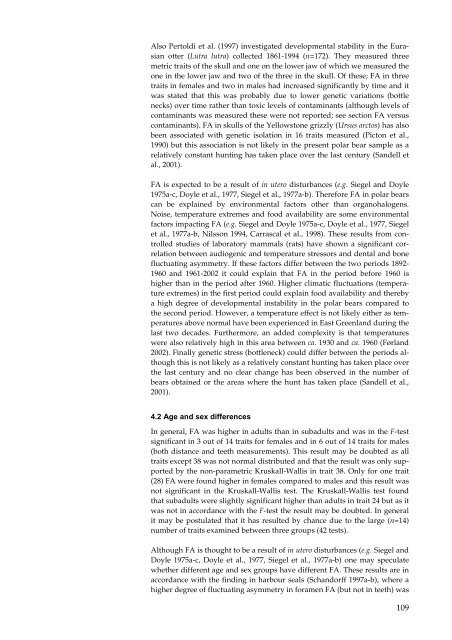Organohalogen concentrations and a gross and histologic ...
Organohalogen concentrations and a gross and histologic ...
Organohalogen concentrations and a gross and histologic ...
Create successful ePaper yourself
Turn your PDF publications into a flip-book with our unique Google optimized e-Paper software.
Also Pertoldi et al. (1997) investigated developmental stability in the Eurasian<br />
otter (Lutra lutra) collected 1861-1994 (n=172). They measured three<br />
metric traits of the skull <strong>and</strong> one on the lower jaw of which we measured the<br />
one in the lower jaw <strong>and</strong> two of the three in the skull. Of these; FA in three<br />
traits in females <strong>and</strong> two in males had increased significantly by time <strong>and</strong> it<br />
was stated that this was probably due to lower genetic variations (bottle<br />
necks) over time rather than toxic levels of contaminants (although levels of<br />
contaminants was measured these were not reported; see section FA versus<br />
contaminants). FA in skulls of the Yellowstone grizzly (Ursus arctos) has also<br />
been associated with genetic isolation in 16 traits measured (Picton et al.,<br />
1990) but this association is not likely in the present polar bear sample as a<br />
relatively constant hunting has taken place over the last century (S<strong>and</strong>ell et<br />
al., 2001).<br />
FA is expected to be a result of in utero disturbances (e.g. Siegel <strong>and</strong> Doyle<br />
1975a-c, Doyle et al., 1977, Siegel et al., 1977a-b). Therefore FA in polar bears<br />
can be explained by environmental factors other than organohalogens.<br />
Noise, temperature extremes <strong>and</strong> food availability are some environmental<br />
factors impacting FA (e.g. Siegel <strong>and</strong> Doyle 1975a-c, Doyle et al., 1977, Siegel<br />
et al., 1977a-b, Nilsson 1994, Carrascal et al., 1998). These results from controlled<br />
studies of laboratory mammals (rats) have shown a significant correlation<br />
between audiogenic <strong>and</strong> temperature stressors <strong>and</strong> dental <strong>and</strong> bone<br />
fluctuating asymmetry. If these factors differ between the two periods 1892-<br />
1960 <strong>and</strong> 1961-2002 it could explain that FA in the period before 1960 is<br />
higher than in the period after 1960. Higher climatic fluctuations (temperature<br />
extremes) in the first period could explain food availability <strong>and</strong> thereby<br />
a high degree of developmental instability in the polar bears compared to<br />
the second period. However, a temperature effect is not likely either as temperatures<br />
above normal have been experienced in East Greenl<strong>and</strong> during the<br />
last two decades. Furthermore, an added complexity is that temperatures<br />
were also relatively high in this area between ca. 1930 <strong>and</strong> ca. 1960 (Førl<strong>and</strong><br />
2002). Finally genetic stress (bottleneck) could differ between the periods although<br />
this is not likely as a relatively constant hunting has taken place over<br />
the last century <strong>and</strong> no clear change has been observed in the number of<br />
bears obtained or the areas where the hunt has taken place (S<strong>and</strong>ell et al.,<br />
2001).<br />
4.2 Age <strong>and</strong> sex differences<br />
In general, FA was higher in adults than in subadults <strong>and</strong> was in the F-test<br />
significant in 3 out of 14 traits for females <strong>and</strong> in 6 out of 14 traits for males<br />
(both distance <strong>and</strong> teeth measurements). This result may be doubted as all<br />
traits except 38 was not normal distributed <strong>and</strong> that the result was only supported<br />
by the non-parametric Kruskall-Wallis in trait 38. Only for one trait<br />
(28) FA were found higher in females compared to males <strong>and</strong> this result was<br />
not significant in the Kruskall-Wallis test. The Kruskall-Wallis test found<br />
that subadults were slightly significant higher than adults in trait 24 but as it<br />
was not in accordance with the F-test the result may be doubted. In general<br />
it may be postulated that it has resulted by chance due to the large (n=14)<br />
number of traits examined between three groups (42 tests).<br />
Although FA is thought to be a result of in utero disturbances (e.g. Siegel <strong>and</strong><br />
Doyle 1975a-c, Doyle et al., 1977, Siegel et al., 1977a-b) one may speculate<br />
whether different age <strong>and</strong> sex groups have different FA. These results are in<br />
accordance with the finding in harbour seals (Sch<strong>and</strong>orff 1997a-b), where a<br />
higher degree of fluctuating asymmetry in foramen FA (but not in teeth) was<br />
109

















